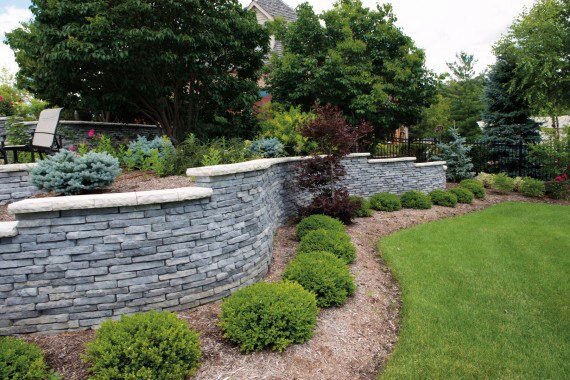There’s something inherently satisfying about seeing a landscape transform, and often, that transformation hinges on the strategic placement of a well-built retaining wall. More than just a functional necessity for managing slopes and preventing erosion, a thoughtfully designed and expertly installed retaining wall can elevate the aesthetic appeal of an outdoor space, turning a challenging grade into a tiered masterpiece or a private, serene garden. But the journey from concept to a lasting, beautiful wall isn’t always straightforward. For anyone embarking on this project, whether as a seasoned professional or a homeowner looking to understand the process better, understanding the core principles of durable and stylish retaining wall installation is paramount.
The Foundation of Longevity: Why Preparation is King
Before a single block is laid or a timber secured, the success of any retaining wall project lies firmly in its preparation. This isn’t just about clearing a space; it’s about understanding the very ground you’re building upon. Any experienced retaining wall installer will tell you that shortcuts taken here inevitably lead to problems down the line, from minor settling to catastrophic failure. We’re talking about proper excavation, ensuring the base is level and compacted to an almost unbelievable degree. Think of it as the bedrock for everything that follows.
Beyond leveling, drainage is another critical, often overlooked, aspect of preparation. Water is the nemesis of retaining walls. Without adequate drainage, hydrostatic pressure can build behind the wall, pushing against it with immense force and eventually leading to bowing, cracking, or even collapse. A properly installed drainage system, typically involving a gravel backfill and a perforated drainpipe at the base of the wall, is non-negotiable. This foresight in planning for water management is what truly separates a temporary fix from a structure built to endure the test of time and weather.
Material Matters: Choosing for Both Strength and Sophistication
Once the groundwork is meticulously laid, the choice of materials comes into play, and this is where the balance between durability and style truly shines. Modern offer a vast array of options, each with its own unique characteristics and aesthetic appeal. From the rustic charm of natural stone to the clean lines of segmental concrete blocks, the possibilities are extensive. The key is to select a material that not only complements the surrounding architecture and landscape but also possesses the inherent strength to withstand the forces it will be subjected to.
For instance, in areas with significant seismic activity or challenging soil conditions, the material choice becomes even more critical. A professional retaining wall installer will be able to guide you through the pros and cons of various options, considering factors like soil type, wall height, and desired aesthetic. While interlocking concrete blocks offer excellent structural integrity and a wide range of colors and textures, natural stone can provide a more organic, timeless look. Timber, on the other hand, can be a cost-effective solution for lower walls, but its lifespan will generally be shorter than masonry alternatives. Understanding these nuances is vital for making an informed decision that meets both your structural needs and your visual preferences.
The Art of Installation: Precision and Reinforcement
With materials chosen and the groundwork prepared, the actual construction phase begins. This is where the skill and precision of the retaining wall installer truly come to the forefront. Laying each course level, ensuring proper setback (if applicable for gravity walls), and integrating geogrid reinforcement where necessary are all crucial steps. Geogrid, a polymeric material, is a game-changer for taller or more heavily loaded walls, significantly enhancing their stability by creating a stronger, more cohesive mass. Its proper placement and overlap are fundamental to preventing slippage and increasing the wall’s resistance to overturning.
Think of it as building a robust, layered cake, where each layer contributes to the overall strength and integrity. For those looking at more complex projects, perhaps terracing a sloped yard or creating multiple levels, the expertise of a specialized retaining wall installer becomes even more invaluable. They possess the knowledge to calculate load bearing, understand soil mechanics, and implement techniques that ensure the wall will not only stand but thrive for decades to come, even in challenging environments like the undulating terrains common in areas such as San Francisco, where robust solutions are often a necessity.
Beyond the Build: Finishing Touches and Long-Term Care
Once the last block is set and the backfill is complete, the retaining wall project isn’t truly finished until the final touches are applied. This is where style really comes into its own. Integrating capstones, adding lighting, or incorporating planting pockets can transform a purely functional structure into a stunning landscape feature. These elements not only enhance the visual appeal but can also add to the wall’s longevity by protecting the top course from weathering and erosion.
Long-term care, while generally minimal for a well-built wall, is still important. Regular inspections for signs of settling, cracking, or drainage issues can help identify minor problems before they escalate. Keeping drainage outlets clear of debris and ensuring vegetation doesn’t compromise the wall’s integrity are simple yet effective maintenance tasks. Ultimately, a successful retaining wall is a testament to meticulous planning, skilled execution, and an appreciation for both the practical and aesthetic aspects of landscape design. It’s a structure that not only holds back the earth but also elevates the beauty of your outdoor living space for years to come.





























